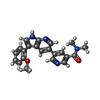+ Open data
Open data
- Basic information
Basic information
| Entry | Database: PDB / ID: 2qoh | ||||||
|---|---|---|---|---|---|---|---|
| Title | Crystal Structure of Abl kinase bound with PPY-A | ||||||
 Components Components | Proto-oncogene tyrosine-protein kinase ABL1 | ||||||
 Keywords Keywords | TRANSFERASE / Abl / kinase / inhibitor | ||||||
| Function / homology |  Function and homology information Function and homology informationRole of ABL in ROBO-SLIT signaling / HDR through Single Strand Annealing (SSA) / RHO GTPases Activate WASPs and WAVEs / Cyclin D associated events in G1 / MLL4 and MLL3 complexes regulate expression of PPARG target genes in adipogenesis and hepatic steatosis / Recruitment and ATM-mediated phosphorylation of repair and signaling proteins at DNA double strand breaks / Turbulent (oscillatory, disturbed) flow shear stress activates signaling by PIEZO1 and integrins in endothelial cells / protein localization to cytoplasmic microtubule plus-end / DNA conformation change / DN4 thymocyte differentiation ...Role of ABL in ROBO-SLIT signaling / HDR through Single Strand Annealing (SSA) / RHO GTPases Activate WASPs and WAVEs / Cyclin D associated events in G1 / MLL4 and MLL3 complexes regulate expression of PPARG target genes in adipogenesis and hepatic steatosis / Recruitment and ATM-mediated phosphorylation of repair and signaling proteins at DNA double strand breaks / Turbulent (oscillatory, disturbed) flow shear stress activates signaling by PIEZO1 and integrins in endothelial cells / protein localization to cytoplasmic microtubule plus-end / DNA conformation change / DN4 thymocyte differentiation / RUNX1 regulates transcription of genes involved in differentiation of HSCs / response to epinephrine / phospholipase C-inhibiting G protein-coupled receptor signaling pathway / podocyte apoptotic process / delta-catenin binding / transitional one stage B cell differentiation / regulation of cellular senescence / regulation of postsynaptic specialization assembly / regulation of modification of synaptic structure / cerebellum morphogenesis / neuroepithelial cell differentiation / B cell proliferation involved in immune response / positive regulation of extracellular matrix organization / positive regulation of Wnt signaling pathway, planar cell polarity pathway / Regulation of actin dynamics for phagocytic cup formation / microspike assembly / B-1 B cell homeostasis / neuropilin signaling pathway / neuropilin binding / regulation of extracellular matrix organization / Myogenesis / bubble DNA binding / positive regulation of establishment of T cell polarity / activated T cell proliferation / positive regulation of blood vessel branching / proline-rich region binding / circulatory system development / negative regulation of mitotic cell cycle / regulation of Cdc42 protein signal transduction / mitogen-activated protein kinase binding / syntaxin binding / alpha-beta T cell differentiation / positive regulation of dendrite development / positive regulation of cell migration involved in sprouting angiogenesis / regulation of axon extension / regulation of T cell differentiation / positive regulation of peptidyl-tyrosine phosphorylation / negative regulation of cell-cell adhesion / neuromuscular process controlling balance / positive regulation of osteoblast proliferation / platelet-derived growth factor receptor-beta signaling pathway / positive regulation of vasoconstriction / platelet-derived growth factor receptor signaling pathway / cell leading edge / Bergmann glial cell differentiation / B cell proliferation / regulation of microtubule polymerization / negative regulation of long-term synaptic potentiation / myoblast proliferation / associative learning / negative regulation of cellular senescence / signal transduction in response to DNA damage / positive regulation of focal adhesion assembly / canonical NF-kappaB signal transduction / negative regulation of BMP signaling pathway / cardiac muscle cell proliferation / ephrin receptor signaling pathway / phagocytosis / positive regulation of T cell migration / endothelial cell migration / BMP signaling pathway / negative regulation of double-strand break repair via homologous recombination / cellular response to transforming growth factor beta stimulus / negative regulation of endothelial cell apoptotic process / ephrin receptor binding / four-way junction DNA binding / spleen development / positive regulation of stress fiber assembly / ruffle / ERK1 and ERK2 cascade / actin filament polymerization / phosphotyrosine residue binding / positive regulation of substrate adhesion-dependent cell spreading / positive regulation of interleukin-2 production / SH2 domain binding / substrate adhesion-dependent cell spreading / positive regulation of mitotic cell cycle / protein kinase C binding / peptidyl-tyrosine phosphorylation / response to endoplasmic reticulum stress / thymus development / positive regulation of release of sequestered calcium ion into cytosol / integrin-mediated signaling pathway / post-embryonic development / B cell receptor signaling pathway / regulation of actin cytoskeleton organization / neural tube closure / non-membrane spanning protein tyrosine kinase activity / non-specific protein-tyrosine kinase / enzyme activator activity Similarity search - Function | ||||||
| Biological species |  | ||||||
| Method |  X-RAY DIFFRACTION / X-RAY DIFFRACTION /  SYNCHROTRON / SYNCHROTRON /  MOLECULAR REPLACEMENT / Resolution: 1.95 Å MOLECULAR REPLACEMENT / Resolution: 1.95 Å | ||||||
 Authors Authors | Zhou, T. / Dalgarno, D. / Zhu, X. | ||||||
 Citation Citation |  Journal: Chem.Biol.Drug Des. / Year: 2007 Journal: Chem.Biol.Drug Des. / Year: 2007Title: Crystal Structure of the T315I Mutant of Abl Kinase Authors: Zhou, T. / Parillon, L. / Li, F. / Wang, Y. / Keats, J. / Lamore, S. / Xu, Q. / Shakespeare, W. / Dalgarno, D. / Zhu, X. | ||||||
| History |
|
- Structure visualization
Structure visualization
| Structure viewer | Molecule:  Molmil Molmil Jmol/JSmol Jmol/JSmol |
|---|
- Downloads & links
Downloads & links
- Download
Download
| PDBx/mmCIF format |  2qoh.cif.gz 2qoh.cif.gz | 128.6 KB | Display |  PDBx/mmCIF format PDBx/mmCIF format |
|---|---|---|---|---|
| PDB format |  pdb2qoh.ent.gz pdb2qoh.ent.gz | 99.6 KB | Display |  PDB format PDB format |
| PDBx/mmJSON format |  2qoh.json.gz 2qoh.json.gz | Tree view |  PDBx/mmJSON format PDBx/mmJSON format | |
| Others |  Other downloads Other downloads |
-Validation report
| Summary document |  2qoh_validation.pdf.gz 2qoh_validation.pdf.gz | 972.6 KB | Display |  wwPDB validaton report wwPDB validaton report |
|---|---|---|---|---|
| Full document |  2qoh_full_validation.pdf.gz 2qoh_full_validation.pdf.gz | 985.7 KB | Display | |
| Data in XML |  2qoh_validation.xml.gz 2qoh_validation.xml.gz | 26.2 KB | Display | |
| Data in CIF |  2qoh_validation.cif.gz 2qoh_validation.cif.gz | 36.7 KB | Display | |
| Arichive directory |  https://data.pdbj.org/pub/pdb/validation_reports/qo/2qoh https://data.pdbj.org/pub/pdb/validation_reports/qo/2qoh ftp://data.pdbj.org/pub/pdb/validation_reports/qo/2qoh ftp://data.pdbj.org/pub/pdb/validation_reports/qo/2qoh | HTTPS FTP |
-Related structure data
| Related structure data |  2z60C  2gqgS C: citing same article ( S: Starting model for refinement |
|---|---|
| Similar structure data |
- Links
Links
- Assembly
Assembly
| Deposited unit | 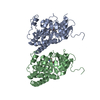
| ||||||||
|---|---|---|---|---|---|---|---|---|---|
| 1 | 
| ||||||||
| 2 | 
| ||||||||
| Unit cell |
|
- Components
Components
| #1: Protein | Mass: 33241.965 Da / Num. of mol.: 2 / Fragment: residues 228-515 Source method: isolated from a genetically manipulated source Source: (gene. exp.)   References: UniProt: P00520, non-specific protein-tyrosine kinase #2: Chemical | #3: Water | ChemComp-HOH / | |
|---|
-Experimental details
-Experiment
| Experiment | Method:  X-RAY DIFFRACTION / Number of used crystals: 1 X-RAY DIFFRACTION / Number of used crystals: 1 |
|---|
- Sample preparation
Sample preparation
| Crystal | Density Matthews: 2.2 Å3/Da / Density % sol: 44.05 % |
|---|---|
| Crystal grow | Temperature: 277 K / Method: evaporation / pH: 8.5 Details: 30% PEG 4K, 0.1M Tris, 0.2M sodium acetate, pH 8.5, EVAPORATION, temperature 277K |
-Data collection
| Diffraction | Mean temperature: 100 K |
|---|---|
| Diffraction source | Source:  SYNCHROTRON / Site: SYNCHROTRON / Site:  APS APS  / Beamline: 19-BM / Wavelength: 0.98 Å / Beamline: 19-BM / Wavelength: 0.98 Å |
| Detector | Type: ADSC QUANTUM 315 / Detector: CCD |
| Radiation | Protocol: SINGLE WAVELENGTH / Monochromatic (M) / Laue (L): M / Scattering type: x-ray |
| Radiation wavelength | Wavelength: 0.98 Å / Relative weight: 1 |
| Reflection | Resolution: 1.95→50 Å / Num. obs: 42995 / % possible obs: 93.8 % / Rmerge(I) obs: 0.083 / Net I/σ(I): 20 |
| Reflection shell | Resolution: 1.95→2.02 Å / Rmerge(I) obs: 0.324 / % possible all: 71 |
- Processing
Processing
| Software |
| ||||||||||||||||||
|---|---|---|---|---|---|---|---|---|---|---|---|---|---|---|---|---|---|---|---|
| Refinement | Method to determine structure:  MOLECULAR REPLACEMENT MOLECULAR REPLACEMENTStarting model: 2GQG Resolution: 1.95→50 Å / σ(F): 0 / σ(I): 0
| ||||||||||||||||||
| Refinement step | Cycle: LAST / Resolution: 1.95→50 Å
|
 Movie
Movie Controller
Controller



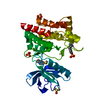

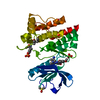
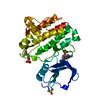
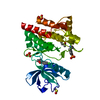
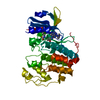
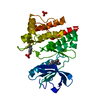
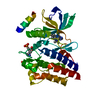
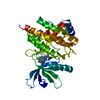
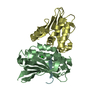
 PDBj
PDBj






